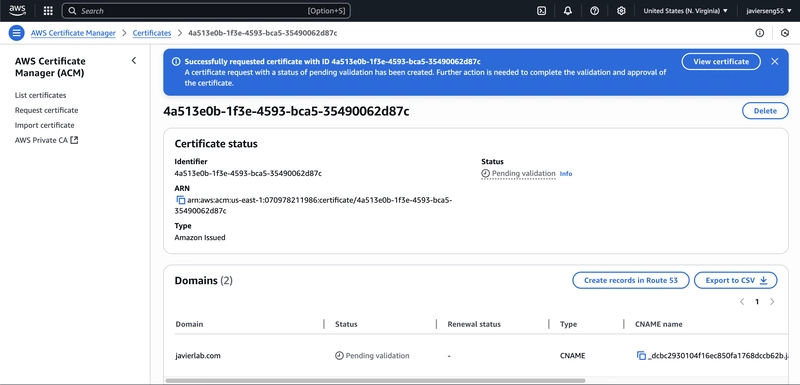Deploying a Static Website on a Custom Domain with HTTPS Using AWS
Overview This project builds on my previous work where I deployed a static website using Amazon S3 and CloudFront. In this phase, I extended the setup to serve the site on a custom domain (javierlab.com) with full HTTPS support, DNS configuration, and a custom 404 error page. The goal was to transform the existing setup into a polished, production-grade deployment. Why This Project Matters (Business Value) A custom domain with HTTPS isn't just a nice-to-have—it's a standard for any serious business or professional online presence. This project demonstrates: Secure delivery with AWS Certificate Manager (ACM) Professional branding with Route 53 and domain configuration Improved UX with a custom error page Scalability and performance using AWS's global edge network via CloudFront Hands-on knowledge of DNS, SSL/TLS, and error routing All these are critical for roles in cloud security, DevOps, and infrastructure automation. What Was Already Set Up From the previous project: A static website was hosted in an S3 bucket: javier-static-site-2025 A CloudFront distribution was set up to serve the S3 content globally This project extends that setup without duplicating it. Step-by-Step Breakdown Step 1: Purchase and Register the Domain Domain javierlab.com was purchased via AWS Route 53 A public hosted zone was automatically created Step 2: Request SSL Certificate in ACM Region used: us-east-1 (N. Virginia) (required for CloudFront SSL) Added both javierlab.com and www.javierlab.com as domain names Selected DNS validation (recommended for automation) Step 3: Validate Domain Ownership Used "Create records in Route 53" to automatically add the necessary CNAME records Waited for AWS to validate the domain (takes a few minutes) Step 4: Upload Custom 404 Error Page Reused the existing S3 bucket (javier-static-site-2025) Uploaded error.html with styling and a link back to the homepage Step 5: Configure CloudFront to Use SSL and Serve Custom Errors Attached the validated ACM certificate to the CloudFront distribution Added alternate domain names: javierlab.com www.javierlab.com Configured a custom error response: HTTP error code: 404 Custom error page path: /error.html Response code: 404 TTL: 10 seconds Step 6: Set Up Route 53 Alias Records Created A records to route traffic to CloudFront: javierlab.com → CloudFront www.javierlab.com → CloudFront Step 7: Test the Setup Opened https://javierlab.com and confirmed successful HTTPS delivery Tested a non-existent page (/thispagedoesnotexist) and confirmed custom 404 handling (Optional) Step: Redirect www.javierlab.com to javierlab.com using S3 To ensure consistent traffic routing and avoid duplicate content across subdomains, I configured a redirection bucket: Created an S3 bucket named www.javierlab.com Enabled static website hosting, but selected “Redirect requests” Target: javierlab.com Protocol: https Created an A record in Route 53 for www.javierlab.com Type: A – IPv4 address Alias: Yes → Targeted the S3 static website endpoint This ensures all traffic going to www.javierlab.com is redirected cleanly to the root domain javierlab.com. Final Thoughts This project refined an existing S3+CloudFront deployment by layering on key production features: HTTPS, domain management, and UX-focused error handling. It’s a clear, job-ready demonstration of practical AWS architecture and hands-on cloud implementation. Perfect foundation for my next move: infrastructure-as-code with Terraform and CI/CD automation. Stay tuned.

Overview
This project builds on my previous work where I deployed a static website using Amazon S3 and CloudFront. In this phase, I extended the setup to serve the site on a custom domain (javierlab.com) with full HTTPS support, DNS configuration, and a custom 404 error page. The goal was to transform the existing setup into a polished, production-grade deployment.
Why This Project Matters (Business Value)
A custom domain with HTTPS isn't just a nice-to-have—it's a standard for any serious business or professional online presence. This project demonstrates:
- Secure delivery with AWS Certificate Manager (ACM)
- Professional branding with Route 53 and domain configuration
- Improved UX with a custom error page
- Scalability and performance using AWS's global edge network via CloudFront
- Hands-on knowledge of DNS, SSL/TLS, and error routing
All these are critical for roles in cloud security, DevOps, and infrastructure automation.
What Was Already Set Up
From the previous project:
- A static website was hosted in an S3 bucket: javier-static-site-2025
- A CloudFront distribution was set up to serve the S3 content globally
This project extends that setup without duplicating it.
Step-by-Step Breakdown
Step 1: Purchase and Register the Domain
Domain javierlab.com was purchased via AWS Route 53
A public hosted zone was automatically created
Step 2: Request SSL Certificate in ACM
Region used: us-east-1 (N. Virginia) (required for CloudFront SSL)
Added both javierlab.com and www.javierlab.com as domain names
Selected DNS validation (recommended for automation)
Step 3: Validate Domain Ownership
Used "Create records in Route 53" to automatically add the necessary CNAME records
Waited for AWS to validate the domain (takes a few minutes)
Step 4: Upload Custom 404 Error Page
Reused the existing S3 bucket (javier-static-site-2025)
Uploaded error.html with styling and a link back to the homepage
Step 5: Configure CloudFront to Use SSL and Serve Custom Errors
Attached the validated ACM certificate to the CloudFront distribution
Added alternate domain names:
- javierlab.com
- www.javierlab.com
Configured a custom error response:
HTTP error code: 404
Custom error page path: /error.html
Response code: 404
TTL: 10 seconds
Step 6: Set Up Route 53 Alias Records
Created A records to route traffic to CloudFront:
javierlab.com → CloudFront
www.javierlab.com → CloudFront
Step 7: Test the Setup
Opened https://javierlab.com and confirmed successful HTTPS delivery
Tested a non-existent page (/thispagedoesnotexist) and confirmed custom 404 handling
(Optional) Step: Redirect www.javierlab.com to javierlab.com using S3
To ensure consistent traffic routing and avoid duplicate content across subdomains, I configured a redirection bucket:
- Created an S3 bucket named www.javierlab.com
- Enabled static website hosting, but selected “Redirect requests”
- Target: javierlab.com
- Protocol: https
- Created an A record in Route 53 for www.javierlab.com
- Type: A – IPv4 address
- Alias: Yes → Targeted the S3 static website endpoint
This ensures all traffic going to www.javierlab.com is redirected cleanly to the root domain javierlab.com.
Final Thoughts
This project refined an existing S3+CloudFront deployment by layering on key production features: HTTPS, domain management, and UX-focused error handling. It’s a clear, job-ready demonstration of practical AWS architecture and hands-on cloud implementation. Perfect foundation for my next move: infrastructure-as-code with Terraform and CI/CD automation.
Stay tuned.









































































































































































![[The AI Show Episode 146]: Rise of “AI-First” Companies, AI Job Disruption, GPT-4o Update Gets Rolled Back, How Big Consulting Firms Use AI, and Meta AI App](https://www.marketingaiinstitute.com/hubfs/ep%20146%20cover.png)

























































































































![[DEALS] The Premium Python Programming PCEP Certification Prep Bundle (67% off) & Other Deals Up To 98% Off – Offers End Soon!](https://www.javacodegeeks.com/wp-content/uploads/2012/12/jcg-logo.jpg)















































.jpg?#)


































































-Mafia-The-Old-Country---The-Initiation-Trailer-00-00-54.png?width=1920&height=1920&fit=bounds&quality=70&format=jpg&auto=webp#)
-Nintendo-Switch-2---Reveal-Trailer-00-01-52.png?width=1920&height=1920&fit=bounds&quality=70&format=jpg&auto=webp#)























_Aleksey_Funtap_Alamy.jpg?width=1280&auto=webp&quality=80&disable=upscale#)
_Sergey_Tarasov_Alamy.jpg?width=1280&auto=webp&quality=80&disable=upscale#)















































































































![Apple Shares Official Trailer for 'Stick' Starring Owen Wilson [Video]](https://www.iclarified.com/images/news/97264/97264/97264-640.jpg)


![Beats Studio Pro Wireless Headphones Now Just $169.95 - Save 51%! [Deal]](https://www.iclarified.com/images/news/97258/97258/97258-640.jpg)













































































































